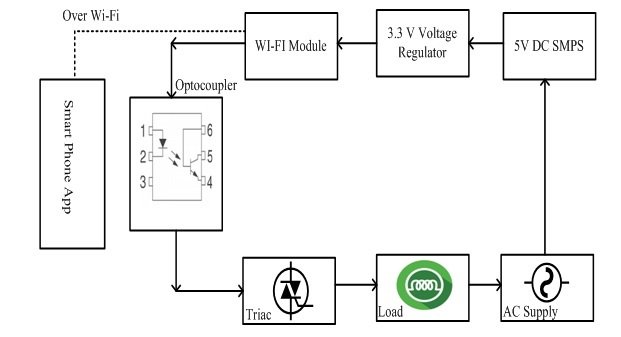IOT Based Load Control Over Standalone Wi-Fi System first of all lets start with introduction to IOT Based Load Control Over Standalone Wi-Fi System. The IOT (Internet of things) based load control over standalone system is very advanced home automation system. In this modern world, every men or women do want to move anywhere, they just want to click the button and done everything. Keep all these things in mind, we are introducing IOT based load control over standalone wi-fi system. By using this system, we can easily control the home appliances automatically through the wi-fi system. Here we have designed this system with the help of microcontroller 18F452 which is belongs to pic family, transformer for connecting this system directly to the wapda power supply, wi-fi module for controlling this system through the wi-fi, optocoupler for isolating two signals and voltage regulator for regulating the dc voltage for supplying the power to the microcontroller, wi-fi module and other component of this system.![IOT based load control over stand alone wifi]](http://microcontrollerslab.com/wp-content/uploads/2017/01/IOT-based-load-control-over-stand-alone-wifi.jpg)
Block Diagram of IOT Based Load Control Over Standalone Wi-Fi System
Figure below is the Block Diagram of IOT Based Load Control Over Standalone Wi-Fi System
Hardware Components List of IOT Based Load Control Over Standalone Wi-Fi System
The IOT based load control over standalone wi-fi system has following hardware components,
Wi-Fi Module: The wi-fi module in IOT based load control over standalone system is used for connecting this system to the wi-fi because this system is totally controlled through the wi-fi. When any one would be send the instruction through the mobile phone or webpage for controlling the load, then these instructions would be received by the wi-fi module and send the signal to the microcontroller to switch on or off the connected load. This is very significant component of this system.
Optocoupler:In IOT based load control over standalone wi-fi system, the optocoupler is used for coupling the wi-fi signal to the microcontroller, without any connection between them. Which consists of photo diode or photo transistor and light emitter. When the light which comes from wi-fi module falls on photo transistor or photo diode then it sends the signal to the microcontroller for on or off the connecting load.
Microcontroller PIC 18F452: In this IOT based load over standalone wi-fi system, the microcontroller is used for controlling this system atomically, which consists of ram, rom and processoretc and is programmed with the help of mikro c language. It is interfaced with optocoupler for receiving the wi-fi signal. When any one send the data or load control signal from smart phone then this signal is received by the wi-fi module and then this signal is received by the microcontroller through the optocoupler. The microcontroller, which is already programmed as per load control signal and then send the load control signal to the output load for on or off this load. This load can also be controlled manually by using the simple switch with this load. It we see the working of a microcontroller then; the microcontroller plays an important role in this IOT based load control over standalone wi-fi system.
Transformer:The transformer, which works on the principle of mutual induction is used for step down the 220v ac to 12v ac for operating the other electronics components. By using this transformer, we can connect this system directly to the wapda power supply.
Bridge Rectifier:In IOT based load control over standalone system, the bridge rectifier is used for the converting the ac voltages into dc voltages for operating the microcontroller, LCD display and wi-fi module.
Voltage Regulator: In IOT based load control over standalone wi-fi system the voltage regulator is used for regulating the 12 dc, which is output of bridge rectifier to 3.3-volt dc and 5 v dc.
LCD Display:The LCD display, in this load control over standalone system is used for displaying the data which is send from the smart mobile phone or displaying the status of connected load.
Triac:The triac is an electronic component, which conducts the current in both direction therefore it is called bidirectional triode thyristor or bilateral triode thyristor. In IOT based load control over standalone wi-fi system the triac relates to the output load for make on or break the output load.
Load:In this IOT based load control over standalone system, the bulb is used as an output load.
Working of IOT Based Load Control Over Standalone Wi-Fi system:
The working of this IOT based load control over standalone wi-fi system is so much simple. When any one or consumer want to control the home or office load then he just opens the webpage from his mobile phone and check the status of his home or office load. Suppose if he wants to off some load then he just clicks the off button from his mobile phone. His mobile phone sends the signal to the wi-fi module which is interfaced with microcontroller through optocoupler. The microcontroller which is interfaced with the triac component. The triac component is connected to the output load. When the microcontroller sends the off-load logic to the traic then the triac off the output load.So by using this system we can easily control our home or office load.
Applications and Advantages of IOT Based Load Control Over Standalone Wi-Fi System:
- This IOT based load control over standalone wi-fi system can be used in your homes as for home automation system for reducing the bill.
- By using this system we can reduce the man power.
- By using this system we can easily the check the load status of our home or offices from anywhere and anytime.
- This system can directly connect to the load supply, no extra power supply is required for this system, this feature also reduce the cost of this system.

send complete project file